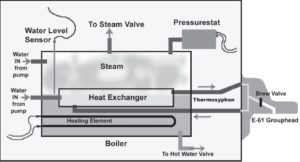 We get this call and email often…
We get this call and email often…
Everything was ok yesterday, but today there’s water everywhere! What happened??
Boiler overfill….
This sometimes happens in heat exchanger machines (HX) and in the steam boilers of of dual boiler machines (usually also a HX boiler) and the answer is often conductivity.
Espresso machines sense the presence of water because it can conduct an electric charge due to dissolved ionic content in the water. To regulate the fill of the boiler, a metal water level sensor (or fill probe) is incorporated into the boiler and when it gets “wet feet”, it is earthed by the ionic content of the water and this results in a “please stop filling me” message at the brain of the espresso machine- the control board.
So what can cause this message to not be received?
If your water is too pure, the ionic content in it may be so low that the water cannot conduct an electrical charge. Perhaps what’s coming out of your tap is just too pure today. Maybe you’re using rainwater from a tank or have switched to a new filter and it’s working too well? You might have purchased some bottled water which is close enough to distilled in mineral content- Pureau is an example. Regardless, your water is just too low in ions today. The boiler continues to fill to overflowing and and the probe never sends a message to the control board: instant grenade! Not really…
Fortunately, your machine is unlikely to explode. All espresso machines have a safety valve fitted and this valve will typically release any excess pressure at 1.5-2.0Bar which is well before your boiler will explode. Water will also often leak from the vacuum valve on the top of the boiler and sometimes from the expansion valve which may drain to the drip tray or perhaps from above the drip tray . This leads to the “There’s water all over the bench and I don’t know what to do!” phone call or email. Often, your home safety switch may have tripped as well because water and 230V AC are not particularly happy bed partners.
The fix is pretty easy and includes a few simple steps:
- Switch off, unplug and let your machine dry out for a day.
- Switch your water to a batch with higher ionic content. Perhaps you might temporarily go back to tap water or 50/50 shandy of what you are using and tap water may help. You might even add a little salt to your water- though we wouldn’t recommend the salt if you have a stainless steel boiler as they don’t get on well. Try sodium bicarb. aka baking soda in this case.
- Once dry, switch the machine on and open the hot water valve into an empty jug. Leave it that way until you hear the pump kick in and the machine drinks from the tank.
- Close the hot water valve and allow the machine to continue to heat.
- Hey presto! (in most cases anyway)
- You’re welcome 😁
If you continue to have issues, there are some other possibilities which will need to be investigated and these will involve technical support.
- There is a fault with your control board or the wiring to the fill probe (…or to the boiler earth. VBM machines are particularly notorious for this)
- The fill probe is covered in debris (often lime scale) and can no longer be earthed by your water
- Your water is just too pure (<30ppm total hardness) and you need to find a more permanent way of increasing your ionic content. A professional water test will be a good idea at this point.
Postscript.
We sometimes receive calls from the owners of Rocket Espresso machines asking why the low water light is flashing when they know that the tank is full. The reasons are exactly the same. Rocket Espresso machines use a pair of probes in the tank coupling below the water tank and if no charge is conducted between those probes, the machine will think it has no water and stop the fill process while switching off the brew element to protect the boiler. It’s just another level of redundancy and is there to help protect from a boiler overfill. It’s not infallible, but generally works pretty well.